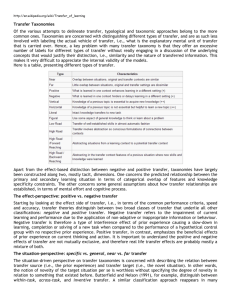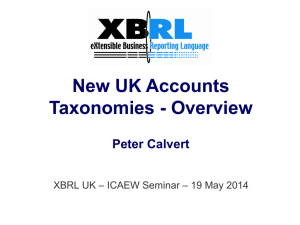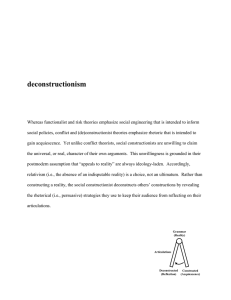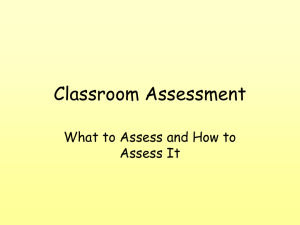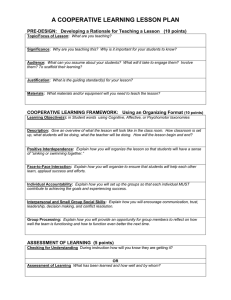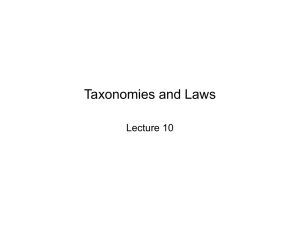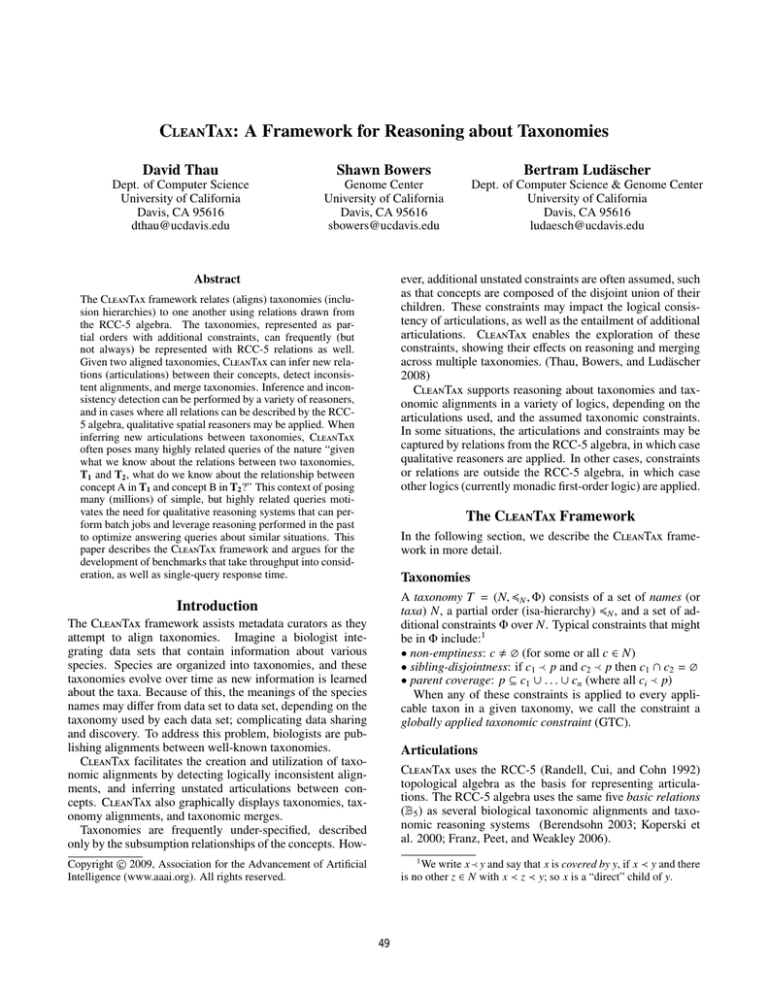
CleanTax: A Framework for Reasoning about Taxonomies
David Thau
Shawn Bowers
Bertram Ludäscher
Dept. of Computer Science
University of California
Davis, CA 95616
dthau@ucdavis.edu
Genome Center
University of California
Davis, CA 95616
sbowers@ucdavis.edu
Dept. of Computer Science & Genome Center
University of California
Davis, CA 95616
ludaesch@ucdavis.edu
ever, additional unstated constraints are often assumed, such
as that concepts are composed of the disjoint union of their
children. These constraints may impact the logical consistency of articulations, as well as the entailment of additional
articulations. CleanTax enables the exploration of these
constraints, showing their effects on reasoning and merging
across multiple taxonomies. (Thau, Bowers, and Ludäscher
2008)
CleanTax supports reasoning about taxonomies and taxonomic alignments in a variety of logics, depending on the
articulations used, and the assumed taxonomic constraints.
In some situations, the articulations and constraints may be
captured by relations from the RCC-5 algebra, in which case
qualitative reasoners are applied. In other cases, constraints
or relations are outside the RCC-5 algebra, in which case
other logics (currently monadic first-order logic) are applied.
Abstract
The CleanTax framework relates (aligns) taxonomies (inclusion hierarchies) to one another using relations drawn from
the RCC-5 algebra. The taxonomies, represented as partial orders with additional constraints, can frequently (but
not always) be represented with RCC-5 relations as well.
Given two aligned taxonomies, CleanTax can infer new relations (articulations) between their concepts, detect inconsistent alignments, and merge taxonomies. Inference and inconsistency detection can be performed by a variety of reasoners,
and in cases where all relations can be described by the RCC5 algebra, qualitative spatial reasoners may be applied. When
inferring new articulations between taxonomies, CleanTax
often poses many highly related queries of the nature “given
what we know about the relations between two taxonomies,
T1 and T2 , what do we know about the relationship between
concept A in T1 and concept B in T2 ?” This context of posing
many (millions) of simple, but highly related queries motivates the need for qualitative reasoning systems that can perform batch jobs and leverage reasoning performed in the past
to optimize answering queries about similar situations. This
paper describes the CleanTax framework and argues for the
development of benchmarks that take throughput into consideration, as well as single-query response time.
The CleanTax Framework
In the following section, we describe the CleanTax framework in more detail.
Taxonomies
A taxonomy T = (N, N , Φ) consists of a set of names (or
taxa) N, a partial order (isa-hierarchy) N , and a set of additional constraints Φ over N. Typical constraints that might
be in Φ include:1
• non-emptiness: c ∅ (for some or all c ∈ N)
• sibling-disjointness: if c1 p and c2 p then c1 ∩ c2 = ∅
• parent coverage: p ⊆ c1 ∪ . . . ∪ cn (where all ci p)
When any of these constraints is applied to every applicable taxon in a given taxonomy, we call the constraint a
globally applied taxonomic constraint (GTC).
Introduction
The CleanTax framework assists metadata curators as they
attempt to align taxonomies. Imagine a biologist integrating data sets that contain information about various
species. Species are organized into taxonomies, and these
taxonomies evolve over time as new information is learned
about the taxa. Because of this, the meanings of the species
names may differ from data set to data set, depending on the
taxonomy used by each data set; complicating data sharing
and discovery. To address this problem, biologists are publishing alignments between well-known taxonomies.
CleanTax facilitates the creation and utilization of taxonomic alignments by detecting logically inconsistent alignments, and inferring unstated articulations between concepts. CleanTax also graphically displays taxonomies, taxonomy alignments, and taxonomic merges.
Taxonomies are frequently under-specified, described
only by the subsumption relationships of the concepts. How-
Articulations
CleanTax uses the RCC-5 (Randell, Cui, and Cohn 1992)
topological algebra as the basis for representing articulations. The RCC-5 algebra uses the same five basic relations
(B5 ) as several biological taxonomic alignments and taxonomic reasoning systems (Berendsohn 2003; Koperski et
al. 2000; Franz, Peet, and Weakley 2006).
c 2009, Association for the Advancement of Artificial
Copyright Intelligence (www.aaai.org). All rights reserved.
1
We write x y and say that x is covered by y, if x ≺ y and there
is no other z ∈ N with x ≺ z ≺ y; so x is a “direct” child of y.
49
Typically, not all of the articulations between concepts in
two taxonomies will be given. The type of reasoner employed to infer these unstated articulations depends largely
on the constraints appear in Φ. When the parent coverage
constraint is not applied to any node in N, all of the relationships fall under the RCC-5 algebra, and therefore a qualitative spatial reasoner may be used. When the parent coverage
constraint is applied, articulations are converted into logic
formulas (Thau and Ludascher 2007) and then a first-order
logic reasoner is applied.
Sometimes the relationship between two concepts is uncertain, and this uncertainty is represented with disjunctions
of the RCC-5 relations. The power set of the basic five relations (R32 ) describes all of the possible disjunctive relations. Many of these R32 relations have been used in the
real-world taxonomic alignments we have considered. In
practice, the aligned taxonomies we have seen can be described by tractable subsets of the R32 relations (Renz and
Nebel 1997). However, this is not necessarily the case, and
particularly when integrating data, it may often be the case
that a problem falls into a non-tractable subset of the RCC-5.
T1
Reasoner Requirements
The CleanTax framework requires a reasoner which can
answer hundreds of thousands of very similar, fairly simple queries. This requirement advocates for reasoners and
benchmarks which stress throughput, rather than singlequery response times. To maximize throughput, a reasoner
should be able to reuse results from previous queries. It
should also be able to schedule queries in a way that might
maximize the possibility for reuse. Optimally, the scheduler
would be able to divide queries into partitions that could be
run in parallel, for cluster computing environments.
Conclusion
We have presented here CleanTax, a framework for applying the RCC-5 algebra toward reasoning about aligned taxonomies. This application of the algebra leads to requirements that may not be common among other qualitative spatial reasoning applications. We hope that the application of
the RCC-5 algebra in this context can motivate requirements
that may generalize to other domains.
Check
consistency
{GTC}1,…,{GTC}n
T2
been devised to limit the number of questions asked (Thau
2008). However in the described scenario, the best optimization still resulted in tens of thousands of queries.
Check
consistency
Union
taxonomies
and
articulations
References
Check
consistency
Generate
goals
Prove
goals
Report
{GTC}1,…,{GTC}n
Articulations
Check
consistency
Intersect
consistent
{GTC}s
{GTC}1,…,{GTC}n
Figure 1: Overview of the CleanTax framework.
Implementation
The CleanTax framework roughly follows the flowchart
shown in Figure 1. Two taxonomies, and the articulations
between them, are each checked for consistency under each
combination of GTCs. The combinations of GTCs which
are consistent for both taxonomies and the articulations are
then applied to the combined taxonomies and articulations,
and again, consistency is checked for each combination of
GTCs. For each surviving combination of GTCs, the relationship between each pair of concepts in the combined
taxonomies is determined by iterating through some set of
the R32 . Once the queries have been asked, the system reports on the relations between each pair of concepts in the
taxonomies. The most complex situation tested to date involved one taxonomy T1 of 218 concepts, one taxonomy T2
of 142 concepts, and a set of 206 articulations between the
taxonomies. There are 142 * 218 = 30956 articulations between the taxonomies, and in a naive brute-force approach,
each of the R32 relations (except ⊥, which never holds as
long as the combined taxonomies and articulations are consistent) should be checked, resulting in 928,680 queries for
a single combination of GTCs. Various optimizations have
50
Berendsohn, W. G. 2003. MoReTax – Handling Factual Information Linked to Taxonomic Concepts in Biology. Number 39 in Schriftenreihe für Vegetationskunde. Bundesamt
für Naturschutz.
Franz, N. M.; Peet, R. K.; and Weakley, A. S. 2006. On
the use of taxonomic concepts in support of biodiversity
research and taxonomy. Proceedings of the New Taxonomy
Symposium.
Koperski, M.; Sauer, M.; Braun, W.; and Gradstein, S.
2000. Referenzliste der Moose Deutschlands, volume 34.
Schriftenreihe Vegetationsk.
Randell, D. A.; Cui, Z.; and Cohn, A. 1992. A spatial logic
based on regions and connection. In Nebel, B.; Rich, C.;
and Swartout, W., eds., KR’92. Principles of Knowledge
Representation and Reasoning: Proceedings of the Third
International Conference. San Mateo, California: Morgan
Kaufmann. 165–176.
Renz, J., and Nebel, B. 1997. On the complexity of qualitative spatial reasoning: A maximal tractable fragment of
the region connection calculus. In IJCAI (1), 522–527.
Thau, D., and Ludascher, B. 2007. Reasoning about
taxonomies in first-order logic. Ecological Informatics
2(3):195–209.
Thau, D.; Bowers, S.; and Ludäscher, B. 2008. Merging
taxonomies under RCC-5 algebraic articulations. In Workshop Proceedings of the 17th International Conference on
Information and Knowledge Management. ACM.
Thau, D. 2008. Reasoning about taxonomies and articulations. In Workshop Proceedings of the 11th International
Conference on Extending Database Technology. ACM.

